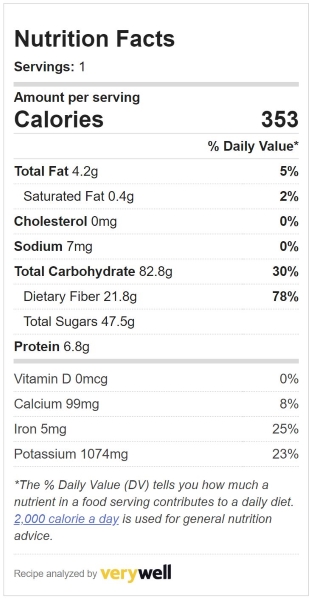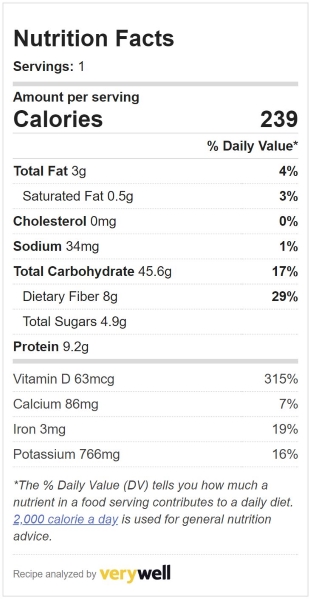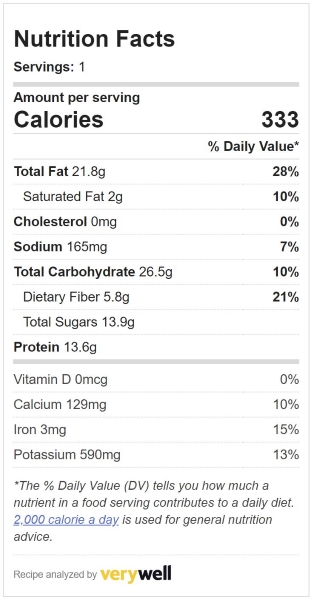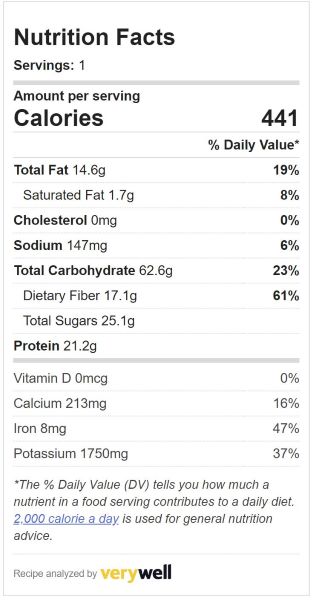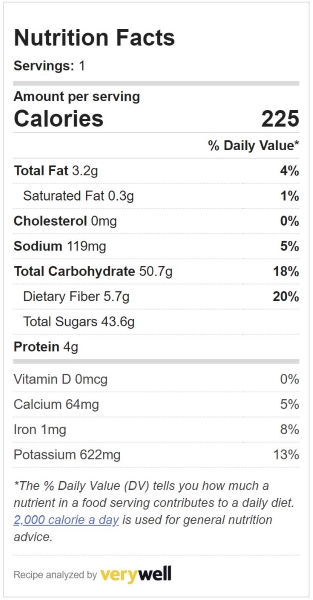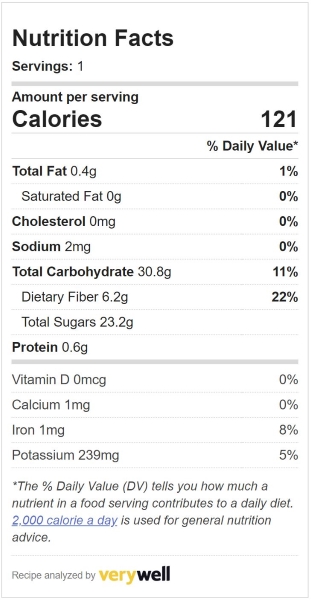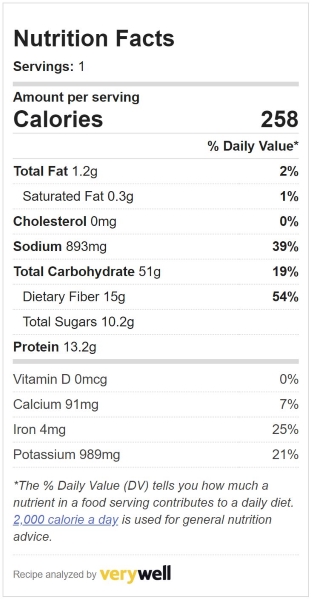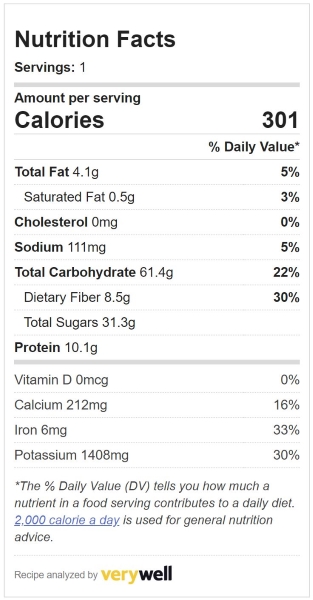A few weekends ago, I spent the day observing and following the nutritional habits of the healthiest type 1 diabetic I know. I made and ate every meal he did at the exact time he had scheduled. And what I saw and learned defied many popular beliefs about the nutritional needs of a diabetic. Like that diabetics should avoid carbohydrates because they raise blood sugar levels, right? Well, 62% of his calories consumed turned out to be carbs. He didn’t seem to be avoiding them but searching for them. And diabetics should avoid fruit because the high sugar concentration causes spikes in blood sugar levels, right? Well, he had fruit at every meal, nearly ten servings of fruit for the day, and one breakfast dish containing four servings of fruit alone. He wasn’t avoiding these either. In fact, these high-carb, high-fruit, and plant-based meals had extraordinarily small effects on his blood sugar levels which I’ll show you soon.
This type 1 diabetic is my dad. He was diagnosed with diabetes at age 29. Type 1 diabetes is a chronic condition where your pancreas produces little-to-no insulin. Without insulin, your body can’t convert blood sugar or glucose into energy needed by cells. It’s not genetic, preventable, or curable. It’s a disease that can only be managed with proper insulin intake, nutrition, exercise, and sleep. And since I was born the same year my dad was diagnosed with diabetes, I’ve only ever known him with this condition. And growing up with someone who is constantly learning, testing, and improving, I’ve gotten to see first-hand how he’s been able to optimize his diabetes management in a way that impresses many around him, including his doctors. This is his optimized daily meal plan for diabetes management:
Breakfast (10am)
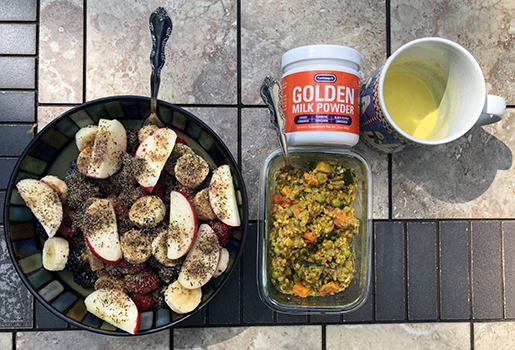
We had the first meal of the day at 10am. It’s a late breakfast for the purpose of increasing the amount of time he spends in a fasted state from the previous day’s dinner. This is commonly known as time-restricted eating which has been shown to help prevent disease, weight gain, and unhealthy aging. We broke the fast with a breakfast by consuming a gigantic fruit bowl, oatmeal, nuts, and a side of tea. This meal was huge, delicious, and extremely filling. It contained nearly 1,000 calories and 36g of fiber. To put that in perspective, the average American consumes 15g of fiber per day and the American Heart Association recommends 25-30g per day. My dad just blew that out of the water on his first meal. What were the effects of this? No crash, no food coma, and no blood sugar spike. His blood sugar reacted as if he didn’t have diabetes. It was steady. And with the extremely high nutrient content of the food, we felt great to start our day.
- 1 Small Apple
- 1 Banana
- 1 cup Strawberries
- 1/2 cup Blueberries
- 1/2 cup Blackberries
- 1/2 cup Raspberries
- 1/2 tsp Amla Powder
- 1/2 tbsp Ground Chia Seed
- 1/2 tbsp Ground Flax Seed
- Dash of Black Cumin
- 1/4 cup Steel Cut Oats
- 1/4 cup Cherry Tomatoes
- 1/4 cup Mushrooms
- 1/4 cup Kale
- 1/4 cup Spinach
- 2 tbsp Carrots
- 2 tbsp Peas
- 2 tbsp Red Onion
- 2 tbsp Sweet Potatoes
- 2 tbsp Zucchini
- 2 cloves Garlic
- 1/4 tbsp Mato Zest (Dr. Fuhrman Product)
- 1/4 tbsp Veggie Zest (Dr. Fuhrman Product)
- Dash of Turmeric, Garlic Powder, Black Pepper, Black Cumin, Nutritional Yeast and Cinnamon
- 1/4 cup Almonds & Raisins (not pictured)
- 1/4 cup Pistachios (not pictured)
- 2/3 cup Soymilk + 1 scoop of Golden Milk Powder (Turmeric, Curcumin, Black Pepper, Ginger, Cardamom, Cinnamon)
Breakfast Totals: 925 calories | 29g fat | 155g carbs | 36g fiber | 30g protein
Tea Break (12pm)
At noon, he scheduled his second of four teas for the day. The morning tea was a spice mix that included turmeric, curcumin, and black pepper designed to decrease body inflammation and prevent disease. The noon tea was an organic hibiscus tea packed with antioxidants designed to lower blood pressure and blood fat levels. His lunch tea, which you’ll see soon, is an Amla tea designed to regulate blood sugar levels and digestion. And his 5pm tea, which I’ll also mention soon, is a Matcha tea that’s designed to protect his liver and brain function. All four were yummy but the morning tea was my favorite of the day from a taste perspective.
Tea
- 1 cup Water
- 1 tea bag Organic Hibiscus Tea
Lunch (2pm)
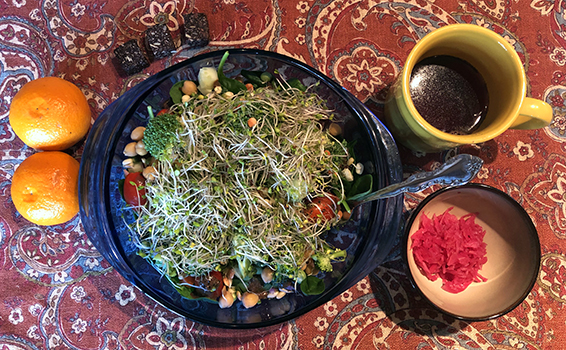
For the second meal of the day, we consumed a veggie packed salad, clementines, Amla tea, a side of sauerkraut and a date/nut snack. If you thought the three servings of vegetables for breakfast was a lot, we tacked on at least five more servings with lunch. It was surprising how large the salad was and how much variety there was to it. This lunch was also pretty filling but came in a lighter form of only 666 calories. Again, this plant-focused high-carb meal didn’t spike his blood sugar and allowed him to maintain a healthy blood sugar level. This is due to the high-fiber content being consumed by eating whole foods. Surprisingly, the salad was delicious too. Who ever said vegetables taste bland?
- 2 cup Spinach
- 1 cup Grape Tomatoes
- 3/4 cup Broccoli
- 1/2 cup Broccoli Sprouts
- 1/2 cup Chickpeas
- 1/4 cup Beets
- 1/4 cup Green Peas
- 1/4 cup Sprout Mix (Mung, Red Lentil, Adzuki)
- 3 tbsp Red Onions
- 3 tbsp Carrots
- 2 tbsp Cucumber
- 2 tbsp Walnut Vinaigrette (Dr. Fuhrman Product)
- 1 tbsp Pine Nuts
- 1 tbsp Pumpkin Seeds
- 1 tbsp Sunflower Seeds
- 1 clove Garlic
- Dash of Black Cumin, Sea Kelp
- 1 serving Ginger, Beet Sauerkraut
- 2 Clementines
- 3 Date Nut Pop’ems (Dr. Fuhrman Product)
- 1 Amla Tea
Lunch Totals: 666 calories | 18g fat | 113g carbs | 23g fiber | 25g protein
Snack (5pm)
Although we ate this 5pm snack at home, he typically consumes this on his drive home from work. Another tea for hydration and health, and an apple for energy and immunity. A quick snack to maintain his blood sugar levels and tide over hunger for dinner.
- 1 Apple
- 1 Matcha Tea
Snack Totals: 121 calories | 0g fat | 31g carbs | 6g fiber | 1g protein
Dinner (7pm)
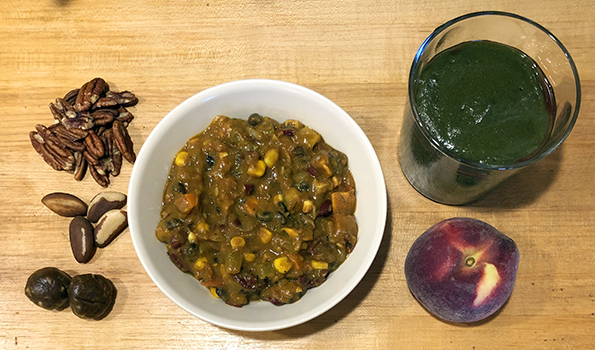
Lastly, for dinner we finished with a bowl of chili, a homemade smoothie, a side of nuts and fruit. Again, another calorie packed meal that’s also extremely nutrient dense. This meal contained a mix of nuts (pecans, brazil nuts), vegetables (corn, onion, pepper, garlic, tomatoes, sweet potatoes), beans (kidney, black beans) and fruit (peach, pineapple, dragon fruit, mango, kiwi, banana). It was a filling and satisfying meal to end the day. It was also the start of a 15-hour fasting window that wouldn’t end until the next day’s 10am breakfast.
- 2 tbsp Onion
- 1 tbsp Pepper
- 1 clove Garlic
- 1 tsp Tomato Paste
- 1/4 cup Black Beans
- 1/2 cup Kidney Beans
- 1/4 cup Vegetable Broth
- 1/4 cup Tomatoes
- 2 tbsp Zuchinni
- 2 tbsp Corn
- 2 tbsp Sweet Potato
- 2 tbsp Carrots
- Dash of Turmeric, Black Cumin, Black Pepper
- Dash of Dr. Fuhrman’s Veggie and Mato Zest
- Dash of Chili Powder, Corn Meal
- 1/2 Frozen Banana
- 1/2 cup Coconut Water
- 1/4 cup Dragon Fruit
- 1/4 cup Pineapple Chunks
- 1/4 cup Mango
- 1 Kiwi
- 1 1/2 cup Kale
- 1/2 tbsp Spirulina
- 1 tbsp Ground Flaxseed
- 1/2 cup Homemade Almond Milk (not pictured)
- 1 Peach
- 2 Date Nut Pop’ems
- 1/4 cup Pecans
- 4 Brazil Nuts
Dinner Totals: 964 calories | 36g fat | 146g carbs | 31g fiber | 31g protein
Daily Totals
And that, is an entire day of eating with a type 1 diabetic. Not at all what you probably pictured. It was a lot of food, from a variety of sources that tasted great. After totaling up all the macros, I found that we had consumed 2,676 calories. That’s a lot! 62% came from carbs, 26% from fat and 12% from protein. Despite this high caloric intake, my dad is about 5’8″ and 138lbs. He’s not at all overweight and is lean. So how does someone consume this many calories without gaining weight?

By consuming a fiber filled diet of plant-based whole foods. At the end of the day, we had consumed 96g of fiber. This is about four times the recommended minimum outlined by the American Heart Association. And fiber has two main benefits. One, the body can’t readily absorb most fiber. This means that those calories aren’t being digested and used by the body. Second, fiber slows the absorption of calories. This means that when you consume a high calorie meal, the fiber prevents the spiking of blood sugar. It’s what allows calories to be absorbed slowly throughout the course of the day which then provides sustained energy levels and prevents fat gain. By looking at the chart generated by my dad’s blood glucose/sugar monitor shown below, we can see the results of this high fiber diet through the day.
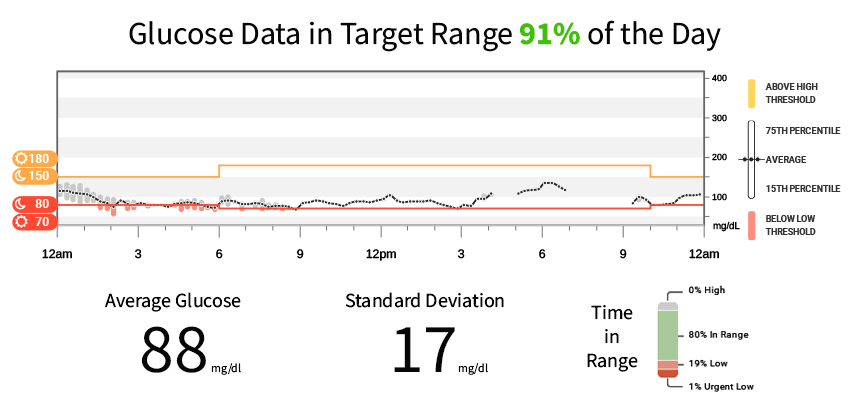
Typically, after a diabetic consumes a meal, they’ll see a spike in their blood sugar as the calories get rapidly absorbed. But with the high fiber meals we were consuming, we didn’t see those spikes. Remember the near thousand calorie breakfast at 10am and dinner at 7pm? No real spikes. Instead, we saw gradual increases and decreases in blood sugar levels that appear more like non-diabetics. This prevents the body from storing excess energy as fat and allows him to maintain a healthy weight. We can also see that this gradual rise and fall of blood sugar allows him to easily stay within the optimal range of 70-180 mg/dl for 91% of the day. That’s an extremely high number that’s hard to attain for a type 1 diabetic. The average time in range for a type 1 diabetic is around 50% and experts recommend people shoot for at least 70%. My dad was 21% higher than expert recommendations. That’s unheard of by most and a testament to his healthy eating habits.
Final Thoughts
Growing up with my dad has been an amazing opportunity to continually learn and grow. We’ve been able to share knowledge, sources, and content to better our nutrition. These experiences are what led me to document and distill the three most important steps we’ve discovered in nutrition. 1) Eat Whole Foods. 2) Stay Plant-Based. 3) Restrict Your Feeding Window. By observing and following my dad’s meal plan, I’ve been able to see exactly what this three-step plan looks like in action and the amazing results. Not only is this the healthiest meal plan for diabetics, but it’s also the healthiest meal plan for nearly all individuals.
Happy Father’s Day Dad!
If you liked this post, please subscribe to the weekly newsletter and follow the social media accounts for the latest content!

Hey, I am Brandon Zerbe
Welcome to myHealthSciences! My goal has always been to increase quality-of-life with healthy habits that are sustainable, efficient and effective. I do this by covering topics like Fitness, Nutrition, Sleep, Cognitive Health, Financial Independence and Minimalism. You can read more about me here.
Sources:
- Nutrition Facts Calculator
- Increasing Fiber Intake
- 10 Proven Health Benefits of Turmeric and Curcumin
- 8 Benefits of Hibiscus Tea
- Amla Tea For Weight Loss: How To Make This Ayurvedic Drink For Fat Burn
- 7 Proven Ways Matcha Tea Improves Your Health
- 5 Things to Know About ‘Time in Range’
Disclosure: I frequently review or recommend products and services that I own and use. If you buy these products or services using the links on this site, I receive a small referral commission. This doesn’t impact my review or recommendation.

